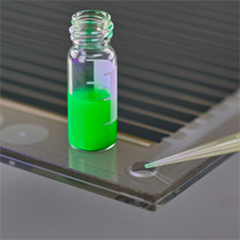Photovoltaics (PV) is one of the key technologies of a sustainable energy supply based on renewable energy. Besides silicon-based photovoltaics, which presently dominates the market, there are other materials, such as perovskite, that also show great potential. Scientists are testing the proof of concept of these new types of solar cells. Very innovative is a new process for fabricating solar cells using sustainable and more resource-friendly methods. Hereby the number of production steps can be drastically reduced by reversing the manufacturing process. Such an in-situ concept for printed perovskite solar cells is being developed by the Fraunhofer Institute for Solar Energy Systems ISE. With a record efficiency of 12.6 %, the researchers have now reached an important milestone in the field of printed photovoltaics.
Today silicon solar cells dominate the global photovoltaic market. They are produced using numerous processing steps starting with the synthesis of the photoactive material through to the solar cell fabrication then subsequently interconnected and encapsulated in a solar PV module. With the material perovskite and the goal of reducing the number of processing steps, the research group around Dr. Andreas Hinsch at Fraunhofer ISE asked the question: Why can’t we reverse the manufacturing process so that first the solar module is produced and subsequently filled with the photovoltaic material then directly activated on site, or “in-situ”? “With perovskite, a photovoltaic material that is currently being intensely investigated, and a photoactive salt, we have now succeeded, for the first time, in realizing a printed solar cell with an efficiency of 12.6 %,” reports a pleased Andreas Hinsch. He adds: “With this success, we have achieved a first, important milestone in upscaling this technology and moving it towards industrial production.” That aside, the certified laboratory efficiency that we reached is also a new record for printed solar cells in general.















